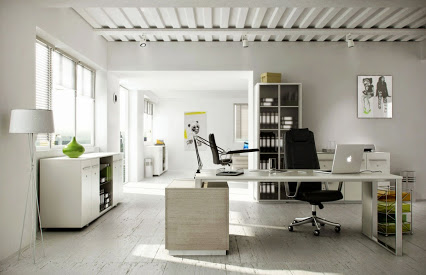My office is my home away from home. It’s where I fight for my place in the business world, where I realize my dreams . . . and it’s part of the public face of my company. I recently moved into a new office space in Cambridge and when decorating I wanted to consider all that. I wanted a productive office that balanced the comforts of home with a professional business image, but I also needed to stick to a budget. Below you can read about the 5 most important things I learned from my re-design.
1. Make First Impressions Count
When you spend all day, every day working in your office, it can be easy to forget how others might see the space. Put yourself in the place of a first-time visitor. What does your office say about your company? Does it present an ordered, well-organized image? Does it reflect a strong, lively business? Is it both a practical workspace and a welcoming environment for visitors and colleagues?
Don’t forget to look at the outside entrance to your office. Is it clean and inviting? Does the reception area make the right first impression? If you usually use a back or side entrance, is the front door clean and accessible? Spending just a few minutes a week keeping things tidy, and investing a few dollars in new plants or a fresh coat of paint, will ensure that first-time visitors see your office the way you want them to see it.

2. Add a Splash of Colour
The ideal office space mirrors, to some extent, the type of work you do. Neutral colours, for example, are a good fit for conservative lines of work such as banking and legal services. And for more creative offices, such as photographers and graphic designers, a warmer, more vibrant approach often makes sense. Either way, make a deliberate decision about your office paint and decor — don’t just accept whatever was there when you moved in.
At the same time, think about how to incorporate your company’s branding into your office decor. Consider where and how to use your business name or logo, and decide whether it’s appropriate to hang a sign outside your office. Issues like where to put your business logo and what colour of paint to use may seem trivial, but they can have a powerful psychological impact when potential customers or clients come calling.
3. Look for Cost-Effective Office Furniture Alternatives
Think an office-supply store is the best place to buy office furniture? Think again. Even buying furniture from a “discount” store can set your business back thousands of dollars. And while leasing furniture may sound like an easy option, it can be even more expensive than buying new furniture.
First, consider acquiring office furniture one piece at a time rather than as a set. By purchasing single pieces with a similar style and colour, you’ll have more options for buying furniture — and nobody is likely to notice the difference.
Real-estate “staging” firms are another great way to acquire high-quality furniture at a low price. Stagers keep large collections of furniture that they use to dress up homes for sale (including home offices). Most of the time a stager’s furniture gets used just a few times and then put up for sale at a steep discount. The International Association of Home Staging Professionals can put you in touch with stagers in your area.
4. Connect with the Local Arts Community
Ever walk into an office and smirk at the “Successory” posters plastered to the walls? So have I — and if that’s my only decorative option, I’d rather stare at a bare wall.
Fortunately, there may be a far more creative alternative available: Consider inviting local artists to display their artwork in your office. It’s a great way to add colour and style to your office while giving artists a place to showcase their work to your clients, customers, and visitors. And depending upon what line of work you’re in, it could also give you a ready-made way to extend your company’s marketing message to a whole new audience.
5. Put Yourself into a Position of Power
You don’t have to be a Feng Shui master to appreciate the impact that aesthetics can have on a productive business environment. Even in strictly practical terms, the decisions you make about where to place office furniture and how to use lighting are worth considering carefully.
In other words, skip the lucky bamboo if you want — but do consider positioning your desk so that you combine personal privacy and comfort with the ability to greet visitors and communicate with co-workers. You may also want to turn off harsh overhead fluorescent lights and add indirect lighting, such as lamps and task lights. And be sure to take full advantage of any natural light available to your workspace. Whether you call this Feng Shui or plain old common sense, it all adds up to an office with a comfortable, practical layout and an atmosphere that’s more conducive to productive work.
